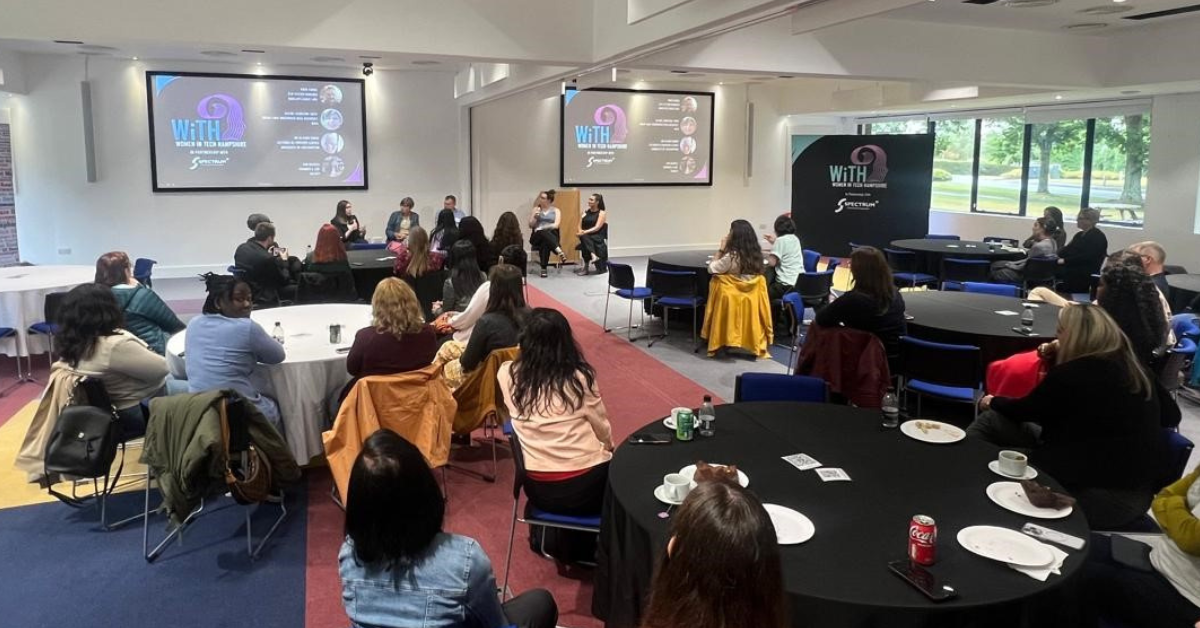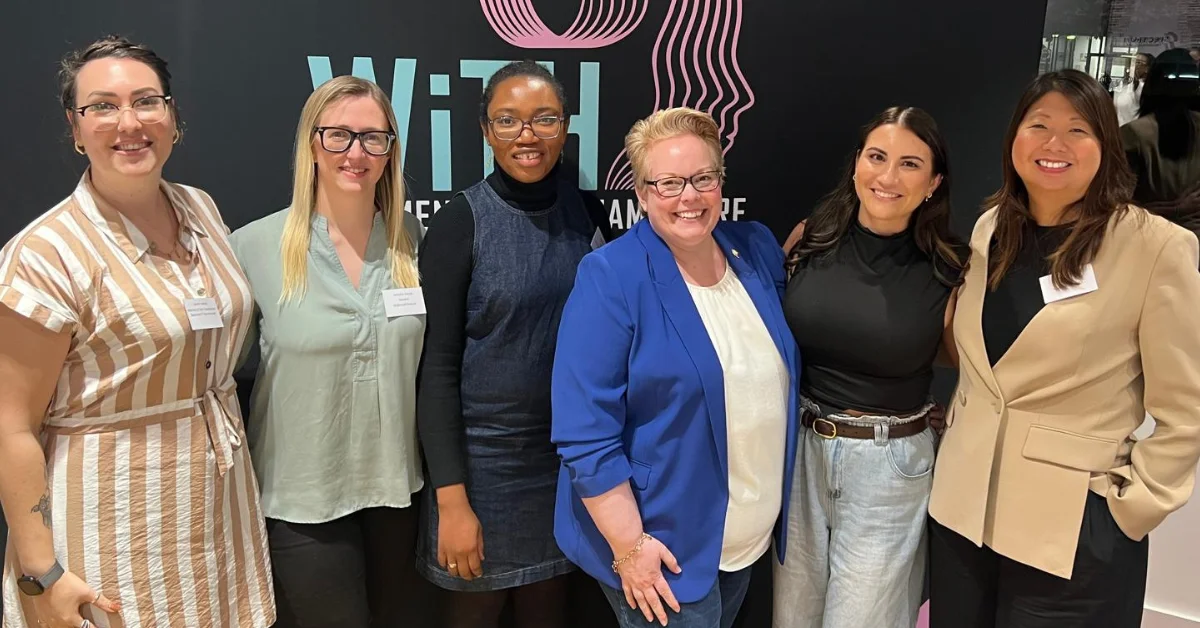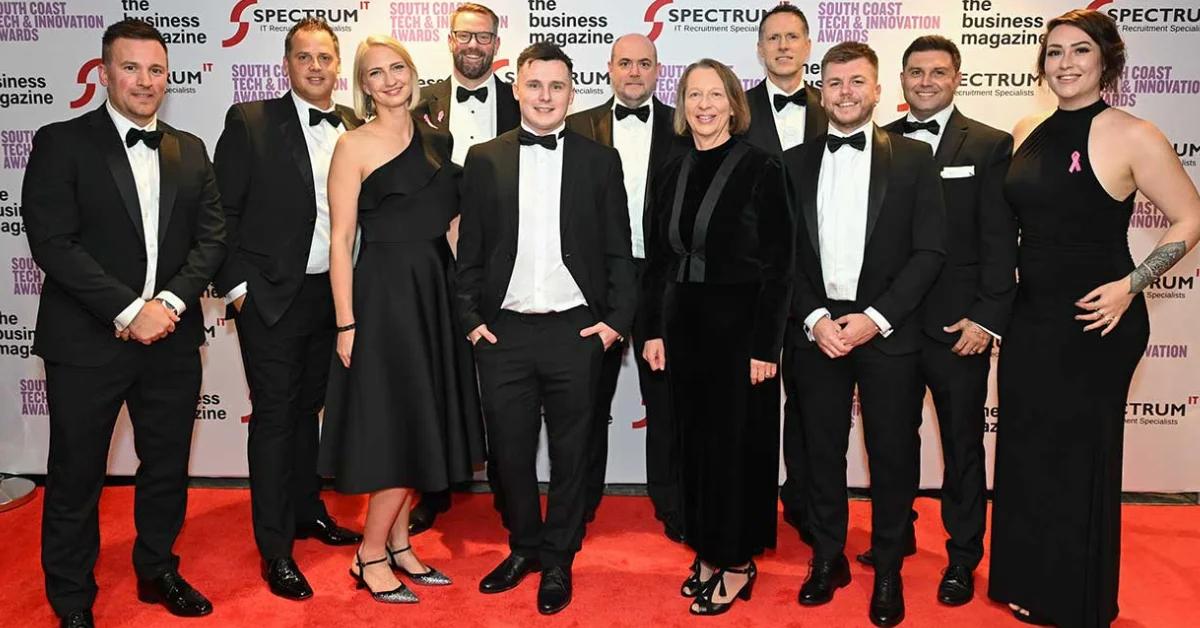
Women in Tech Hampshire - Attracting, Retaining, and Male Allies
31 Jul, 202413 minutes
Attracting and retaining women in tech
Our Women in Tech Hampshire (WiTH) events focus on key topics and concerns impacting women in tech. For our July meeting, we explored how to attract and retain women in the tech industry, as well as the importance of having male allies.
Once again, we were proud to have an expert panel made up of inspiring and motivational speakers, as well as an energetic room of likeminded participants keen to learn and network. A fantastic atmosphere, plenty of engaging conversation and a positive vibe made this one of the best meetings of WiTH to date!
Here is our round-up of the key talking points for those who couldn’t make the event or need a recap.
The expert panel
We had an incredible line-up of speakers for this month’s meeting, each bringing their own perspective to the conversation.
Sam Gaskell is the Founder and CEO of Hampshire-based DataFit, which helps businesses to organise, manage and analyse their data. The team do consultancy work, which covers data management, data security and data flow, as well as personalised training around data management best practice. Sam has been working in tech and data for over 13 years. She began her career in data as a Data Quality Analyst at Virgin Care, before moving up the career ladder in a number of different companies, including British Gas and Marks and Spencer. She wanted to be more involved as a leader and decision maker, but didn’t see many women in the industry pushing for change. This inspired her to set up her own business in 2022.
Rachel Harrison-Smith is the Group Chief Enterprise Data Architect for healthcare company Bupa, and also has a long history of working in data. Starting out in the early 1990s, Rachel was one of the only women in the tech industry who was specialising in data. She recalls sitting in plenty of meetings over the years as the only woman present, and sometimes the only woman on a project as a whole. Her career has seen her work for Royal Bank of Scotland and HSBC, among others, before taking her current role in 2021.
Dr Richard Gomer has been a lecturer in Computer Science at the University of Southampton for the last three years, working with between 1,500 and 2,000 students a year. He is passionate about encouraging more women and those from marginalised communities to study technology-based subjects and pursue a career in the industry. He’s keen to share techniques, as well as gain greater insight into how a university can encourage more STEM participation from women.
Encouraging women at a young age
Encouraging more women to choose a career in STEM starts in education, encouraging and supporting students to engage with these subjects. Working in a university environment, Richard says that on his courses around 20% of applicants and 20% of students are female. He acknowledges that while this is higher than average, it isn’t as high as he’d like, and it’s important to consider retention. He explains that, “Keeping female students together on projects and encouraging them to take an active role in projects helps them to feel more engaged and makes them feel seen”.
Part of the problem with encouraging girls and young women to pursue a STEM-based career is that there is a lot of stereotyping and a lack of visible female role models. Richard explains that it’s hard to work around that typical media representation of a computer science ‘geek’ locked in a dark room on a computer, and a university’s role needs to extend to changing this narrative while presenting more diverse leaders in STEM fields.
Breaking these stereotypes needs to start even earlier than university level, by which point many girls have already felt put off of STEM subjects. Rachel says that it feels like most women have a story about how they felt discouraged from going into STEM by their school or their caregivers. Which is why she says it’s important for women who are in successful STEM careers to be visible as role models and to get involved in school career days, user groups and educational programs at an early stage to reach and encourage young people of all backgrounds. Being seen as a role model can give young girls representation in the industry and make them feel like it’s achievable.
Sam agreed that role models for school-age girls is one of the key points, as well as changing perceptions and stereotypes. She recalls that at school her work experience was in a nursery and other girls were also pushed into typical ‘caregiver’ roles as that was considered the norm, something that has to change for more women to move into STEM fields. Sam’s putting herself out there as an inspiration too, by joining the role model scheme at social enterprise Next Tech Girls. She also encourages workplaces to take part in programs that encourage women into STEM, such as the implementation of apprenticeships, placements or degree apprenticeships.
Creating a supportive environment
For those women who then opt to follow a career path into the tech industry, a supportive and inclusive environment can help to retain them, but we were curious as to what the key factors to achieve this are.
As Sam suggests, it’s about businesses having clear objectives regarding what they want to achieve when it comes to inclusive workplaces, and having board members and decision makers on board who are committed to creating an inclusive environment. This means also encouraging men and male allies to take part in programs that support women in STEM. Rachel agreed with all these points, and says that it’s no good having ‘token gestures’ around flexibility, support and inclusivity, when it needs to be a company-wide ethos, reflected in everything the business does.
Richard suggests that in order to drive change, there needs to be diverse leaders in business, with companies welcoming and open to those from different backgrounds. This helps to attract a more diverse pool of applicants, who are then more likely to stay long-term, which in turn creates a more inclusive environment, widening a company’s appeal even further.
Flexibility is a key component and a simple option that businesses can offer to be more welcoming to women. In our last WiTH meeting, Donna Wayman, Chief Operating Officer for Zurich Legacy Solutions, talked about a 40% increase in female applicants by offering part-time and job-share positions. As well as flexible working, Sam says that there should also be supportive return-to-work policies in place, and being able to have honest, adult conversations around expectations when coming back to work. It’s not only women that benefit from these policies; as Richard says, “It should just be good policy for a company to be flexible and have adult conversations around what support people need.”
How male allies can play a part
Encouraging more women to take up roles in the tech industry shouldn’t be a problem for only women to solve; it’s an industry problem, not a women problem. “It has to be a team effort and [there needs to be a] supportive environment to raise those issues in,” says Richard. He says that there is a need for genuine allies, who can bring the energy to push through changes and make it happen.
Rachel agrees that it’s a team effort and it isn’t an ‘us’ versus ‘them’ situation. She advocates for policy changes that also encourage men to take longer paternity leave, and for men to take more ownership of how flexibility and a balanced working environment benefits them too.
Men, particular in leadership roles, can actively do a lot to support women in their workplace. Sam suggests that this can include things like providing support and programs for women progressing their career, encouraging them to share ideas, and ensuring that women are not overshadowed in meetings or at networking events. “Allow women to give themselves credit and provide a platform for them to be proud of what they achieve,” she suggests. In short, provide a safe space for women to take more risks.
At this point, the panel were asked an important question: “What would you ask men to do to support the movement?” – and our panellists had some great suggestions. Richard suggests that men can learn to listen and ask how they can help, while resisting the urge to ‘mansplain’, and to be an active ally, calling out other men and exploring how to support women. Rachel suggests that men can help with early intervention in education: “Representation is so important for young people, and they need to see both men and women encouraging women into STEM to make them really believe it’s a realistic career path”. Meanwhile, Sam says that men can choose to elevate and make women visible in a business and in the policies that are implemented.
The topic of this WiTH led to some passionate discussion and engagement, with a lot of great ideas shared. We’re grateful to our experts on the panel for their time and energy, and for making this another very successful evening.
If you’re interested in speaking or learning more about Women in Tech Hampshire, please reach out to Amy Lee and/or Lauren James. Details about upcoming events can be found on the Women in Tech Hampshire LinkedIn page.




